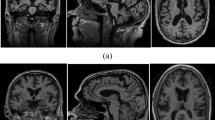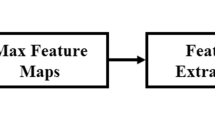Abstract
Dementia is an irreversible chronic neuro-disorder. Prediction of preclinical stages variation in dementia disorder helps to delay the progression. This study attempts to differentiate the brainstem (BS) structures for normal and different demented stages. BS structure is interconnected with many brain cortical structures that help to provide valuable pathological information about atrophy. This work is carried out using ADNI public database. Initially, skull-stripped MR images are used to perform BS segmentation using moth flame optimization-based multilevel Tsallis entropy method. Architecture such as AlexNet, GoogleNet and SqueezeNet is considered to extract features. The fusion of these features provides optimal information about BS structures for preclinical stages. The performance of fused deep features is evaluated using heat map and occlusion sensitivity map. Further, combined feature selection is carried out to extract the most distinct feature set using mutual information, minimum redundancy maximal relevance and recursive feature elimination methods. Finally, the analysis of variance is used to evaluate inter and intra-class variation of the subject. Results indicate that the suggested approach could segment the BS prominently. The correlation value was found to be > 0.97 in all the considered stages. The heatmap and occlusion sensitivity show the fused deep features provide highly discriminative features. The statistical performance of this fused feature set of Normal (CN)/EMCI, CN/EMCI, CN/LMCI, CN/MCI, CN/AD, EMCI/MCI, EMCI/AD, MCI/LMCI, MCI/AD and LMCI/AD shows high significant variation (p < 0.0001). Consequently, this approach captures the complex preclinical stage variation effectively and suitable to reduce the misdiagnosis rates.









Similar content being viewed by others
Explore related subjects
Discover the latest articles and news from researchers in related subjects, suggested using machine learning.Data availability
The datasets analysed in the proposed work are available in the following public domain resources: [https://adni.loni.usc.edu/data-samples/access-data/].
References
Ge C, Qu Q, Yu-Hua GuI, Jakola AS (2019) Multi-stream multi-scale deep convolutional networks for Alzheimer ’s disease detection using MR images. Neurocomputing 350:60–69. https://doi.org/10.1016/j.neucom.2019.04.023
Kaabouch G (2019) A deep learning approach for diagnosis of mild cognitive impairment based on MRI images. Brain Sci 9(9):217. https://doi.org/10.3390/brainsci9090217
Bi X, Xu Q, Luo X, Sun Q, Wang Z (2018) Analysis of progression toward Alzheimer’s disease based on evolutionary weighted random support vector machine cluster. Front Neurosci 12:716. https://doi.org/10.3389/fnins.2018.00716
Saad SHS, Alashwah MMA, Alsafa AA, Dawoud AM (2020) The role of brain structural magnetic resonance imaging in the assessment of hippocampal subfields in Alzheimer’s disease. Egypt J Radiol Nucl Med. https://doi.org/10.1186/s43055-020-00164-8
Gorji HT, Kaabouch N (2019) A deep learning approach for diagnosis of mild cognitive impairment based on MRI images. Brain Sci 9(9):217. https://doi.org/10.3390/brainsci9090217
Simic G, Stanic M, Mladinov N, Jovanov M, Kostovic I, Hof PR (2009) Does Alzheimer disease begin in brainstem? Neuropathol Appl Neurobiol 35(6):532–554. https://doi.org/10.1111/j.1365-2990.2009.01038.x
Ji X, Wang H, Zhu M, He Y, Zhang H, Chen X, Gao W, Fu Y (2021) Brainstem atrophy in the early stage of Alzheimer’s disease: a voxel-based morphometry study. Brain Imaging Behav 15:49–59. https://doi.org/10.1007/s11682-019-00231-3
Uematsu M, Nakamura A, Ebashi M, Hirokawa K, Takahashi R, Uchihara T (2018) Brainstem tau pathology in Alzheimer’s disease is characterized by increase of three repeat tau and independent of amyloid β. Acta Neuropathol. Commun 6(1):1. https://doi.org/10.1186/s40478-017-0501-1
Rohini P, Sundar S, Ramakrishnan S (2020) Differentiation of early mild cognitive impairment in brainstem MR images using multifractal detrended moving average singularity spectral features. Biomed Signal Process Control 57:101780. https://doi.org/10.1016/j.bspc.2019.101780
Ge C, Qu Q, Yu-Hua GuI, Jakola AS (2019) Multi-stream multi-scale deep convolutional networks for Alzheimer’s disease detection using MR images. Neurocomputing 350:60–69. https://doi.org/10.1016/j.neucom.2019.04.023
Patenaude B, Smith SM, Kennedy DN, Jenkinson M (2011) A Bayesian model of shape and appearance for subcortical brain segmentation. Neuroimage 56(3):907–922. https://doi.org/10.1016/j.neuroimage.2011.02.046
Li C, Gore JC, Davatzikos C (2014) Multiplicative intrinsic component optimization (MICO) for MRI bias field estimation and tissue segmentation. Magn Reson Imaging 32(7):913–923. https://doi.org/10.1016/j.mri.2014.03.010
Preeti M, Manik S, Sanjeev KS (2021) A comprehensive meta-analysis of emerging swarm intelligent computing techniques and their research trend. J King Saud Univ - Comput Inf Sci. https://doi.org/10.1016/j.jksuci.2021.11.016
Aziz MAE, Ewees AA, Hassanien AE (2017) Whale optimization Algorithm and moth-flame optimization for multilevel thresholding image segmentation. Expert Syst Appl 83:242–256. https://doi.org/10.1016/j.eswa.2017.04.023
Debendra M, Ratnakar D, Banshidhar M (2020) Automated breast cancer detection in digital mammograms: A moth flame optimization based ELM approach. Biomed Signal Process Control 59:101912. https://doi.org/10.1016/j.bspc.2020.101912
Govindarajan S, Swaminathan R (2020) Differentiation of COVID-19 conditions in planar chest radiographs using optimized convolutional neural networks. Appl Intell 51(5):2764–2775. https://doi.org/10.1007/s10489-020-01941-8
Zhengying L, Hong H, Yule D, Guangyao S (2020) DLPNet: A deep manifold network for feature extraction of hyperspectral imagery. Neural Netw 129:7–18. https://doi.org/10.1016/j.neunet.2020.05.022
Chen B, Li J, Guo X, Lu G (2019) DualCheXNet: dual asymmetric feature learning for thoracic disease classification in chest X-rays. Biomed Signal Process Control 53:101554. https://doi.org/10.1016/j.bspc.2019.04.031
Boussaad Leila, Boucetta Aldjia (2022) Deep-learning based descriptors in application to aging problem in face recognition. J King Saud Univ - Comp Info Sci 34(6):2975–2981. https://doi.org/10.1016/j.jksuci.2020.10.002
Toğaçar M, Ergen B, Cömert Z (2020) Classification of white blood cells using deep features obtained from convolutional neural network models based on the combination of feature selection methods. Appl Soft Comput 97:106810. https://doi.org/10.1016/j.asoc.2020.106810
Demirhan A (2018) The effect of feature selection on multivariate pattern analysis of structural brain MR images. Physica Med 47:103–111. https://doi.org/10.1016/j.ejmp.2018.03.002
Iglesias JE, Liu C-Y, Thompson PM, Zhuowen Tu (2011) Robust brain extraction across datasets and comparison with publicly available methods. IEEE Trans Med Imaging 30(9):1617–1634. https://doi.org/10.1109/TMI.2011.2138152
Azimbagirad M, Simozo FH, Senra Filho ACS, Murta JLO (2020) Tsallis-entropy segmentation through MRF and Alzheimer anatomic reference for brain magnetic resonance Parcellation. Magn Reson Imaging 65:136–145. https://doi.org/10.1016/j.mri.2019.11.002
Kaur K, Singh U, Salgotra R (2020) An enhanced moth flame optimization. Neural Comput Appl 32:2315–2349. https://doi.org/10.1007/s00500-021-06560-0
Billah M, Waheed S (2020) Minimum redundancy maximum relevance (mRMR) based feature selection from endoscopic images for automatic gastrointestinal polyp detection. Multimed Tools Appl 79:23633–23643. https://doi.org/10.1007/s11042-020-09151-7
Maltar J, Marković I, Petrović I (2020) Visual place recognition using directed acyclic graph association measures and mutual information-based feature selection. Rob Auton Syst 132:103598. https://doi.org/10.1016/j.robot.2020.103598
Padmavthi K, Sri RKK (2017) Detection of bundle branch block using adaptive bacterial foraging optimization and neural network. Egypt Inform J 18(1):67–74. https://doi.org/10.1016/j.eij.2016.04.004
Diego O, Salvador H, Erik C, Gonzalo P, Omar A, Jorge G (2017) Cross entropy based thresholding for magnetic resonance brain images using crow search algorithm. Expert Syst Appl 79:164–180. https://doi.org/10.1016/j.eswa.2017.02.042
Rallabandi VPS, Tulpule K, Gattu M (2020) Automatic classification of cognitively normal, mild cognitive impairment and Alzheimer’s disease using structural MRI analysis. Inf Med Unlocked. https://doi.org/10.1016/j.imu.2020.100305
Abbas A, AbdelsameaGaber MMMM (2021) Classification of COVID-19 in chest X-ray images using DeTraC deep convolutional neural network. Appl Intell 51:854–864. https://doi.org/10.1007/s10489-020-01829-7
Funding
Not applicable for the submitted work.
Author information
Authors and Affiliations
Corresponding authors
Ethics declarations
Conflict of interest
The author declares no conflict of interest exits in the submission of this manuscript.
Additional information
Publisher's Note
Springer Nature remains neutral with regard to jurisdictional claims in published maps and institutional affiliations.
Rights and permissions
Springer Nature or its licensor (e.g. a society or other partner) holds exclusive rights to this article under a publishing agreement with the author(s) or other rightsholder(s); author self-archiving of the accepted manuscript version of this article is solely governed by the terms of such publishing agreement and applicable law.
About this article
Cite this article
Priyanka, A., Ganesan, K. Severity estimation of brainstem in dementia MR images using moth flame optimized segmentation and fused deep feature selection. Neural Comput & Applic 35, 9093–9104 (2023). https://doi.org/10.1007/s00521-022-08167-4
Received:
Accepted:
Published:
Issue Date:
DOI: https://doi.org/10.1007/s00521-022-08167-4




